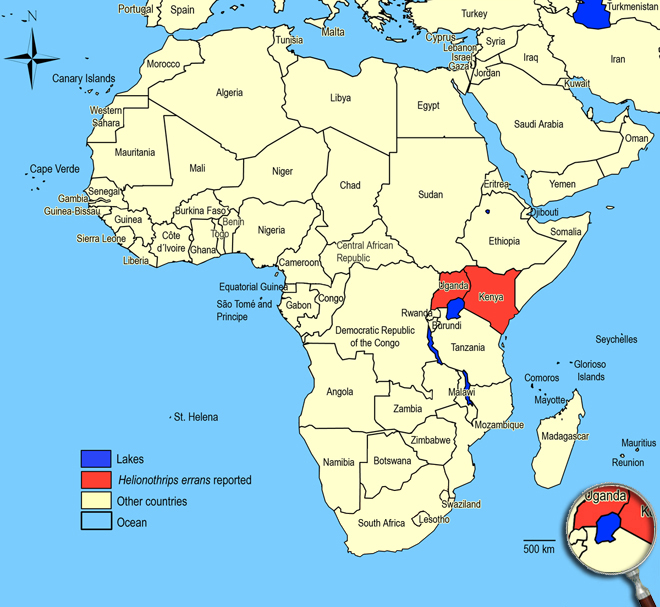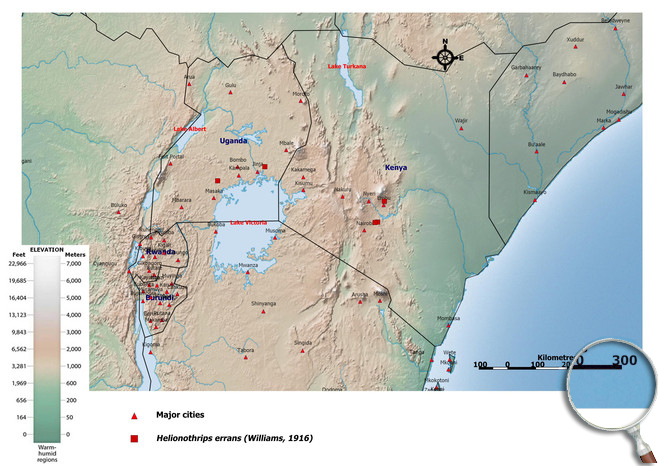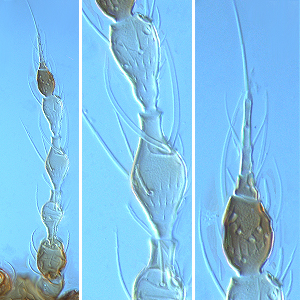Helionothrips errans (Williams, 1916)
Panchaetothripinae, Thripidae, Terebrantia, Thysanoptera
Figures
Fig. 1: 8-segmented antenna, segments III and IV with forked sense cone, terminal segments VI-VIII
Fig. 2: Head dorsal with ocellar triangle
Fig. 3: Head and pronotum
Fig. 4: Meso- and metanotum
Fig. 5: Meso- and metasternum with lyre-shaped furca
Fig. 6: Meso- and metasternum plates
Fig. 7: Fore- and hind wing, fore wing distal region
Fig. 8: Tergites III-VI
Fig. 9: Tergite VIII with posteromarginal comb and tergite IX
Fig. 10: Sternite VII and base of ovipositor valves
Introduction and recognition
Helionothrips errans occurs on the leaves of orchids. Female macropterous; body dark brown; head yellow anterior of fore ocellus; tarsi and apical third of mid and hind tibiae yellow; antennal segments I, II & VI brown, VII & VIII grey brown, III-V pale yellow; fore wing brown, with white transverse band sub-basally and diffuse paler area sub-apically. Antennae 8-segmented; segments III and IV with long apical neck and long forked sense cone, VIII about five times as long as VII (Fig. 1). Head with short, convex cheeks; occipital ridge strong and close to posterior margin of eyes; reticulation strong in front of occipital ridge but weak on posterior collar (Fig. 2). Pronotum reticulate, with semicircular hind margin and no long setae (Fig. 3). Metanotum with triangular area of strong sculpture, bearing 1 pair of widely spaced setae but no campaniform sensilla (Fig. 4); metafurca lyre-shaped (Fig. 5 and 6). Mid and hind tarsi 1-segmented. Fore wing first vein close to or fused to costal vein; second vein with 6 or 7 setae; first vein with 6 setae at base and 2 distally; costal cilia longer than costal setae, posteromarginal cilia wavy (Fig. 7). Tergites III-VII with distinctive sculpture on antecostal ridge forming a series of about 5 arches (Fig. 8); VIII with comb of long trichoid teeth, usually medially incomplete (Fig. 9); X with median split complete. Sternites II-VII with 3 pairs of long centrally located setae (Fig. 10).
Male similar to female; sternites VII & VIII each with a small circular glandular area near anterior margin; tergite IX with 2 pairs of spine-like setae and a group of about 6-10 small tubercles on posterior half of tergite.
Taxonomic identity
Species
Helionothrips errans (Williams, 1916)
Taxonomic history
Hercinothrips errans Bagnall, 1932
Heliothrips errans Williams, 1916
Common name:
Bean thrips
Present taxonomic position:
Family: Thripidae Stephens, 1829
Subfamily: Panchaetothripinae Bagnall, 1912
Genus: Helionothrips Bagnall, 1932
Genus description
The genus Helionothrips Bagnall, 1932
This genus includes 27 described species, mostly from the Asian region, but with 3 from Africa, one from Australia, and one from South America that is possibly not congeneric (Mound & Marullo 1996). Members of Helionothrips have distinctive tergal sculpture forming a series of arches on the antecostal ridges of each abdominal segment, the head has a transverse ridge dorsally, and the sense cone on antennal segments III & IV is forked. It is possible that the character states used to distinguish between members of Helionothrips are subject to more inter-population variation than the keys given by Wilson (1975).
Species description
Typical key character states of Helionothrips errans
Coloration and body sculpture
Body color: mainly brown to dark brown
Surface of head, pronotum and fore legs: with heavy, often polygonally reticulate sculpture
Sculptured reticles on head and pronotum: with no internal markings
Antennae
Number of antennal segments: 8
Form of sense cones on antennal segments III and IV: emergent and forked on segments III and IV
Forked sense cone on antennal segment IV: extending to a point at least a third to base of segment V
Terminal antennal segments: VI-VIII forming a single unit
Head
Head occipital collar: in contrast to rest of head weakly sculptured
Cheeks shape: constricted to basal neck
Head: not prolonged in front of compound eyes (misinterpreted: distinctly prolonged)
Head - occipital ridge dorsally: present
Ocelli: present
Prothorax
Pronotal blotch or internal apodeme: absent
Pronotum shape: broadly rectangular
Pronotum surface: with mainly equiangular reticulations
Mesothorax
Mesonotum: with an incomplete median division
Metathorax
Metanotum with dominant sculptured triangle medially: with weakly defined reticulate triangular area medially
Shape of metathoracic furca: elongate and lyre-shaped
Wings
Fore and hind wings: present, more than half as long as abdomen (macropterous)
Fringe cilia arising: from sockets
Fore wing veins: present
Fore- and hind wing surface: covered with microtrichia
Fore wing extreme apex color: dark
Fore wings: alternating bands of dark and light, or pale with dark areas
Apex of fore wing: with prominent terminal setae
Fore wing anterior margin (costal vein): with setae and cilia but cilia longer than setae
Fore wing costal fringe cilia: arising at anterior margin of wing
Fore wing first vein: close to or fused to costal vein
Fore wing first vein setal row: incomplete, with setae not closely and uniformly spaced
Fore wing second vein setal row: complete, setae uniformly spaced
Fore wing shape: mainly parallel sided or margins run continuously towards each other
Fore wing surface: not reticulate
Fringe cilia on posterior margin near apex: distinctly wavy (undulated)
Length of fore wing costal setae at middle of wing: longer than half of median wing width
Legs
Color of fore tarsi: pale or yellow, sometimes apical shaded or brown
Mid and hind tarsi: with one segment
Abdomen
Tergites: with distinctive tergal sculpture forming a series of horseshoe-like arches on the antecostal ridges
Tergite II: without numerous recurved claw-like microtrichia anterolaterally
Tergites IV and V median setal pair: shorter than distance between their bases
Tergites V to VII: without ctenidia laterally, but sometimes with rows of microtrichia
Tergite VIII ctenidia: without paired ctenidia laterally, sometimes with irregular microtrichia
Tergite VIII posteromarginal comb of microtrichia: present laterally, incomplete medially
Tergite VIII shape of posteromarginal microtrichia: long, slender and irregular or regular
Tergite VIII to X: without unusually long and stout setae
Tergite X: not tubular, longitudinally incomplete
Setae on abdominal tergite X: all setae slender

Similar or related species
Compared to other Panchaetothripini, Helionothrips errans has a distinctive tergal sculpture forming a series of horseshoe-like arches on the antecostal ridges of each abdominal segment. The genus is apparently most closely related to Hercinothrips, but differs in having 1-segmented tarsi, a distinct sculptured triangle medially on the metanotum, and the anterior vein of fore wing only with a few scattered setae (Hercinothrips with 2-segmented tarsi, without dominant sculptured median triangle on the metanotum, and fore wing first vein setal row almost complete). Compared to other Panchaetothripinae with a distinct occipital ridge dorsally on head, only in Helionothrips errans and Panchaetothrips noxius the occipital collar is in contrast to the rest of the head weakly sculptured (in Xestothrips glabratus there is no difference between surface sculpture of occipital collar and the rest of the head; in Monilothrips kempi the occipital collar is in contrast to the rest of head heavy reticulate sculptured).
Biology
Life history
Eggs are laid in the orchid leaves by the adult female. After about a week, an immature (or nymph) emerges and starts feeding on the leaf surface. The nymphs go through four stages before becoming adults, with all stages feeding on the orchid leaf tissues. It is likely under optimal conditions such as glass house that the entire life cycle can be completed in about a month (Gillespie 2008).
Host plants
Crops: cassava, coffee, karela (bitter melon), onion, orchids (Dendrobium, Laelia).
Weeds: Galinsoga parviflora, Solanum incanum.
Vector capacity
None identified, but possible mechanical distribution of phytopathogenic fungi and bacteria.
Damage and symptoms
The feeding damage results from these pests sucking the cell contents from the epidermal and underlying cells of the orchid leaf giving initially a ‘silvered’ look to the leaf but this quickly browns and dies off, possibly causing leaf fall of extensively damaged plants (Gillespie 2008).
Detection and control strategies
-
Additional notes
-
Biogeography
Recorded widely in greenhouses of temperate regions (USA and Europe) and in the tropics (Taiwan and Africa). Kenya, Uganda.
African countries where Helionothrips errans has been reported

Occurence of Helionothrips errans in East Africa

Please click here for survey sites of all observed thrips species of Kenya, Tanzania and Uganda.
Click here for locations of Helionothrips errans in parts of East Africa.

Bibliography
Bagnall RS (1932). Brief descriptions of new Thysanoptera - XVII. Annals and Magazine of Natural History, Zoology, Botany and Geology. (Serie 10) 10: 505-520
Gillespie P (2008). New thrips pest of orchids. NSW Department of Primary Industries, Primefact No. 817, 3 pp
Kudo I (1992). Panchaetothripinae in Japan (Thysanoptera, Thripidae), 2. Panchaetothripini, the genus Helionothrips. Japanese Journal of Entomology. 60 (2): 271-289
le Pelley RH (1959). Agricultural Insects of East Africa. East African High Commission, Nairobi, Kenya, 307 pp
Lewis T (1973). Thrips: their biology, ecology and economic importance. Academic Press Inc., London Ltd., 349 pp
Morison GD (1957). A review of British glasshouse Thysanoptera. Transactions of the Royal Entomological Society of London. 109 (16): 467-534
Moritz G (2006). Thripse. Pflanzensaftsaugende Insekten, Bd. 1, (1. Auflage). Westarp, Hohenwarsleben, 384 pp. ISBN-13: 978 3 89432 891 7
Moritz G, Morris DC & Mound LA (2001). ThripsID - Pest thrips of the world. ACIAR and CSIRO Publishing Collingwood, Victoria, Australia, CDROM ISBN 1 86320 296 X
Mound LA (2009). New taxa and new records of Australian Panchaetothripinae (Thysanoptera, Thripidae). Zootaxa. 2292: 25-33
Mound LA & Kibby G (1998). Thysanoptera: An identification guide, (2nd edition). CAB International, Wallingford and New York, 70 pp
Mound LA & Marullo R (1996). The thrips of Central and South America: An introduction (Insecta: Thysanoptera). Memoirs on Entomology, International, Vol. 6. Associated Publishers, Gainsville, 487 pp
Palmer JM, Mound LA & du Heaume GJ (1989). 2. Thysanoptera, 73 pp. In Betts CR [ed.], CIE Guides to insects of importance to man. CAB International, Wallingford, Oxon, UK
Williams CB (1916). Biological and systematic notes on British Thysanoptera. The Entomologist. 49: 221-227; 243-245; 275-284
Wilson TH (1975). A monograph of the subfamily Panchaetothripinae (Thysanoptera: Thripidae). Memoirs of the American Entomological Institute. 23: 1-354
zur Strassen R (2003). Die terebranten Thysanopteren Europas und des Mittelmeer-Gebietes. Die Tierwelt Deutschlands und der angrenzenden Meeresteile nach ihren Merkmalen und nach ihrer Lebensweise, 74. Teil. Goecke & Evers, Keltern, Germany, 277 pp
----
Web links
Mound´s Thysanoptera pages
Thysanoptera Checklist
ICIPE Thrips survey sites
UNI Halle & Thrips sites
Thrips of California














